Somewhere in the mid-1950s, my grandfather, Leo Dupuich, acquired a number of bonsai from a local landscaper and bonsai enthusiast named Jim Miyasaki. When my teenage father saw the trees, one stuck out to him – a Japanese plum.
My dad cared for the tree for a number of years before giving it to my mom when they were in high school. It’s been in the family ever since.
The tree is now close to seventy years old. As a result, health problems are becoming more frequent. The most common problems have been discoloration in the tips of leaves (yellow fading to brown) and occasional twig loss, but this year there are more problems than usual.
Here’s a photo of the tree from May.
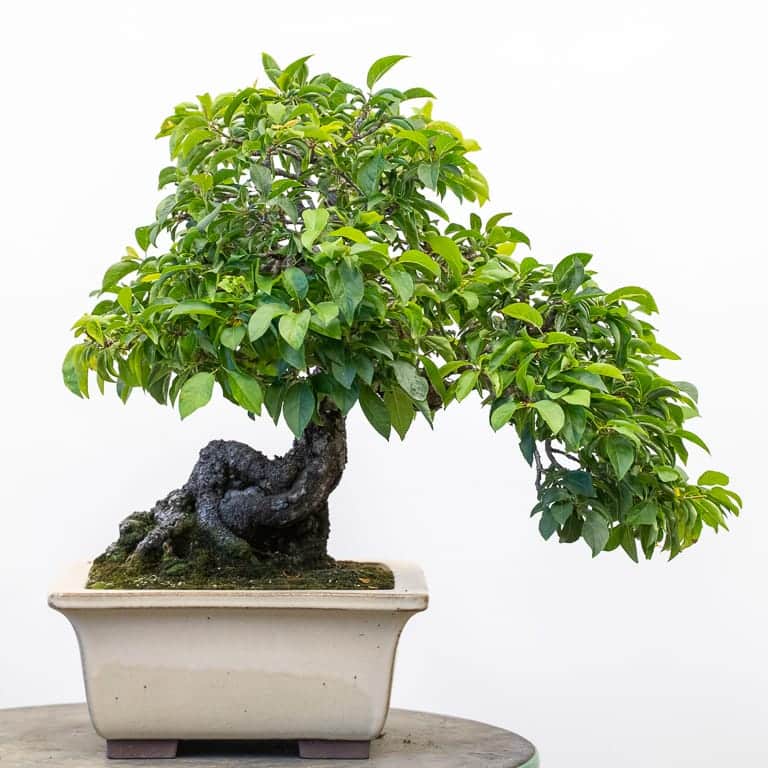
Japanese plum (possibly Prunus salicina) – 17″
Over summer, several small branches showed signs of stress. The first symptom was general weakness and curled leaves.
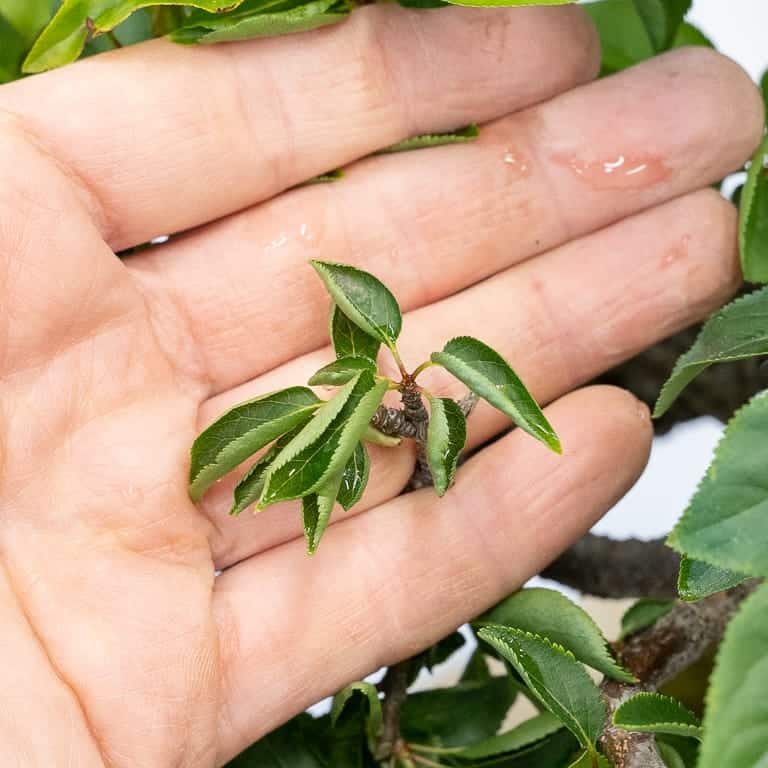
Weak leaves
Over time, the affected twigs died back.
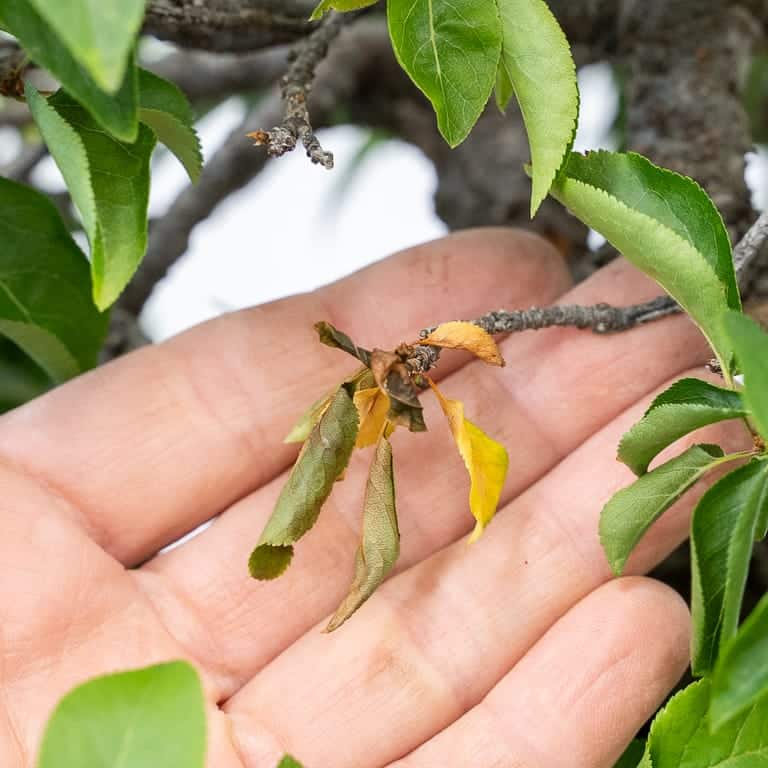
Dead foliage
I also found branches that looked chlorotic. If the whole tree was yellow, I’d assume it needed iron or more general fertilizer, but because the problem was localized, I was concerned something else was going on.
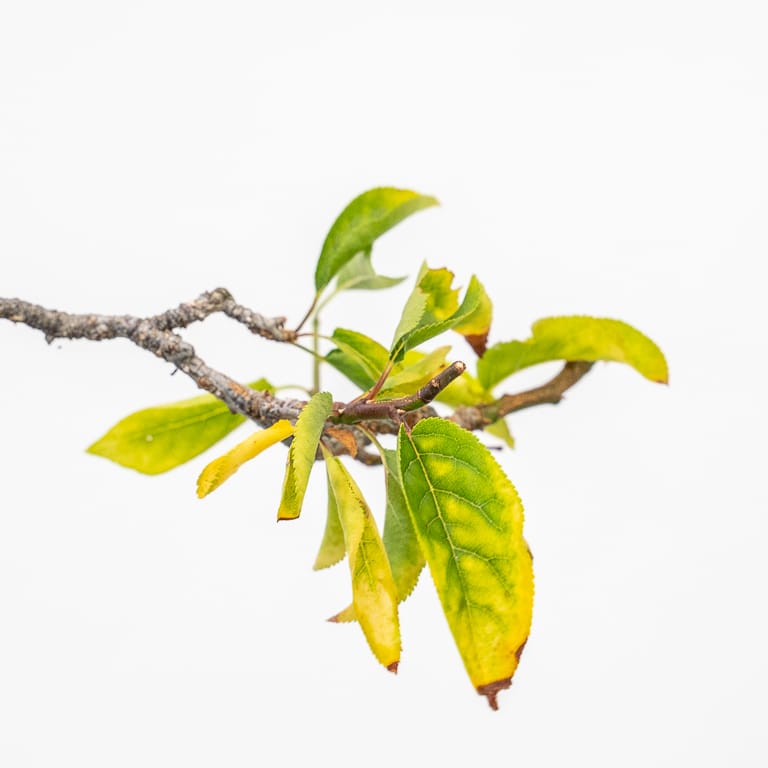
Discolored foliage
Then, after some unseasonably hot weather, I saw yellow spots on some leaves. When I turned the leaves over, I found signs of rust.
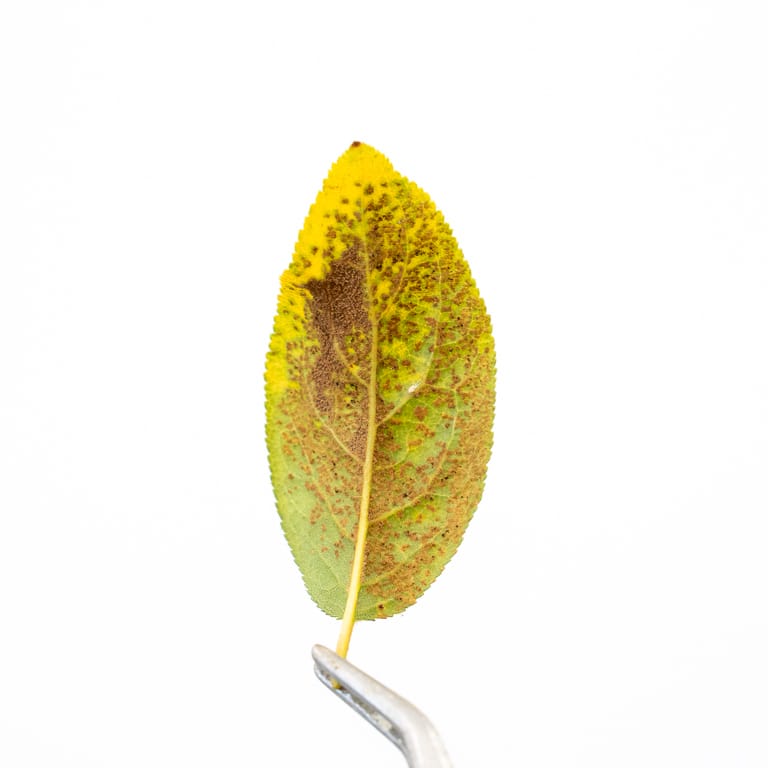
Fungus growing on the underside of a leaf – the tiny white dot is a lone mealy bug
For reference, here is what relatively healthy leaves look like at this time of year.
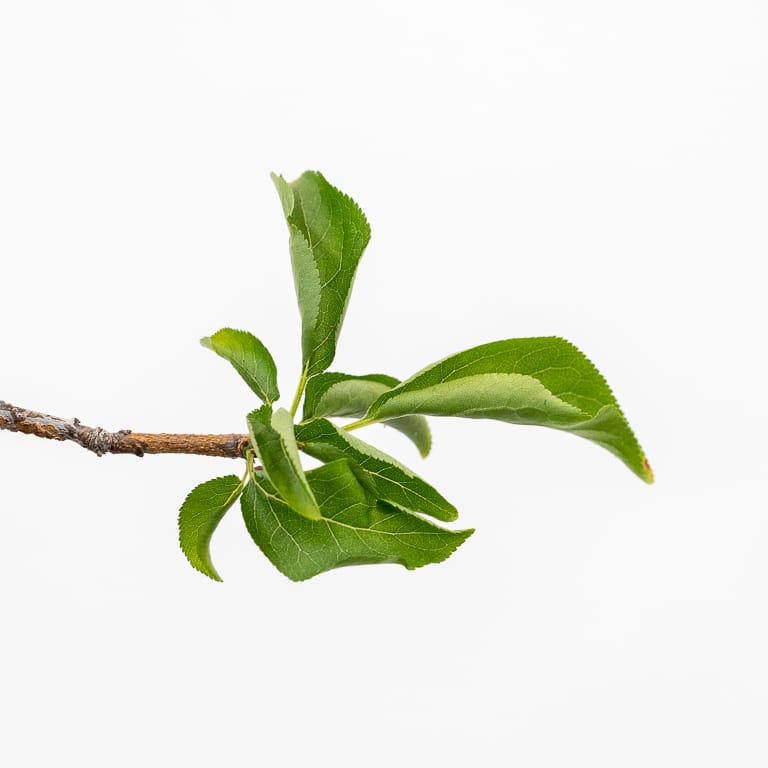
Healthy plum foliage
I wasn’t sure how many problems were affecting the tree so I took samples from different areas of the tree and sent them to a lab.
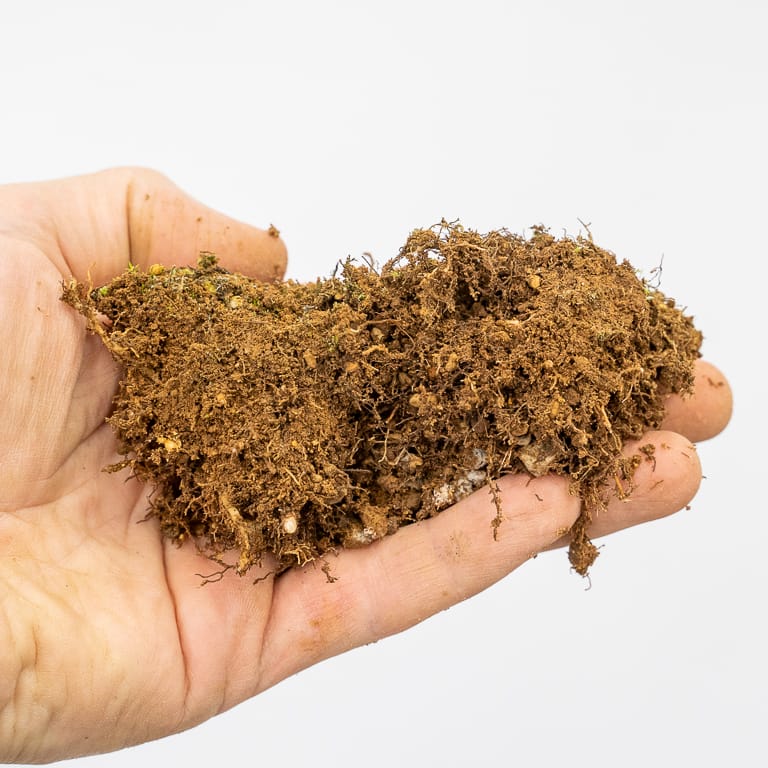
Soil sample containing fine roots
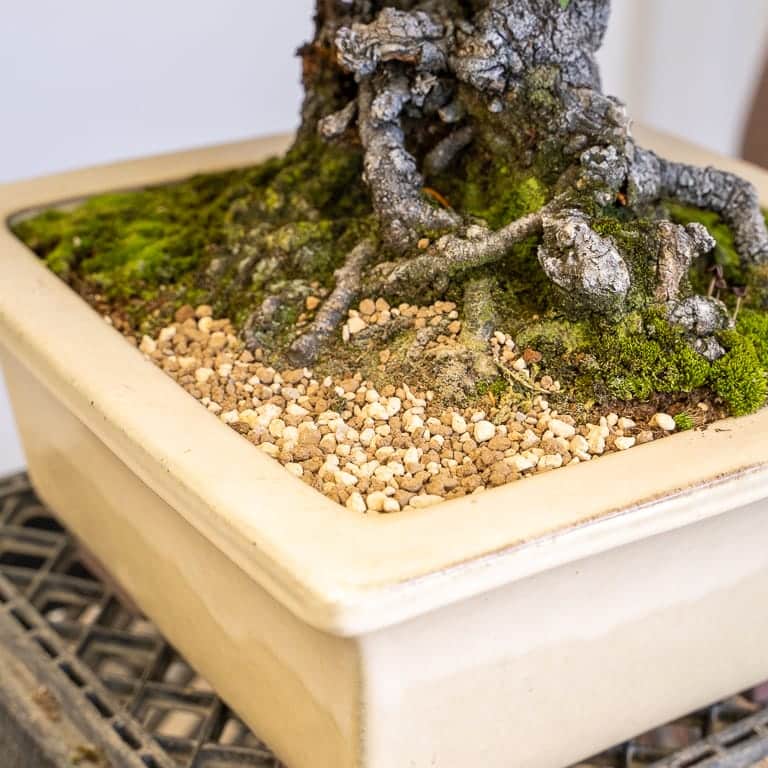
After filling in the gap caused by taking a soil sample

Samples in plastic bags with strips of paper towels to absorb excess moisture
I sent the samples to Waypoint Analytical, and a few weeks later received the results. The soil and twig samples were free of pathogens, but a Transchelia species was cultured from the foliage samples.
Upon seeing the diagnosis, I took the familiar step of looking up the pathogen on the University of California Integrated Pest Management site.
The U.C.’s I.P.M. website is my go-to resource for learning about new pests or pathogens (here is a link to their Transchelia reference).
The site suggests best practices for avoiding the problem as well as for treatment. As it happens, I have several fungicides that are effective for Transchelia, so I applied one (azoxystrobin) and will make a note to follow up with subsequent treatments according to the guidance on the label.
More importantly, I moved the tree to a sunnier corner of the garden. In previous years I kept the tree under thirty percent shade cloth even though it can do well in full sun on all but the hottest days. This year the tree was under forty percent shade cloth which likely contributed to the wet conditions that fungi need to take hold.
I don’t know that Transchelia is responsible for all of the symptoms I found on the tree, but by treating for it, I can rule it out if some of the symptoms return down the road.
In the meantime, I’ll be keeping a close watch on the tree and will do whatever I can to return it to health.
Subscribe to Bonsai Tonight
New Posts Delivered Every Tuesday and Friday
Thomas Tynan says
70 years is along time for a plum tree to be alive ; do you think this is why in Japan they often bud graft onto UME to re-invigorate the tree? Regards Tom
Jonas Dupuich says
Hi Tom – the most common reason for grafting ume is because they don’t back bud well. I used to graft an ume every year for a long time because cutting past the leaves often resulted in dieback.
Lars Grimm says
Great post. It looks like you sent in a decent amount of soil. My local cooperative extension asks for a “generous double handful of feeder roots and one quart of soil”.
https://projects.ncsu.edu/cals/plantpath/extension/clinic/submit-sample.html#required
That’s obviously a problem for many of my smaller plants. Have you found that you can still get good results with smaller soil amounts?
Jonas Dupuich says
Thanks, Lars! I’ve had the same issue. The main thing they want is roots large enough to preserve some healthy tissue by the time it arrives at the lab. I usually try to grab more soil so I can include at least one pencil-sized root and the fine roots around it, but I didn’t want to do any more invasive work this time of year. This could result in false negatives which leaves open the possibility of sending better (and bigger) samples when I repot in winter.
Terence Vaughn Krista says
Great article. Here’s hoping you can clear up some confusion. You state that you have a Japanese plum, or ume. A cursory search online presents some ongong confusion between ume and mume. I believe Prunus mume is the Latin name for flowering apricot but there is no Latin Prunus ume. I believe ume is simply the Japanese word for plum. Flowering plum is usually termed Prunus cerasifera or Prunus blireiana (which itself is a cross between Prunus cerasifera and Prunus mume, adding to the confusion). They also have purple leaves. So just to clarify, you seem to have a fruiting plum, which I think is Prunus domestica. Is that correct? I ask because I have a both a bonsai Prunus mume and a bonsai plum I dug up from a hillside in San Francisco over 20 years ago. It has green leaves and lovely white flowers in the spring and if allowed produces lots of small yellow plums. I think you would simply term it Prunus domestica, or plum, or ume. My ume, although generally quite healthy. always has some twig dieback, as in your third picture. It appears an organic solution of the plant ridding itself of weak branches. It happens every year shortly after flowering. Also, just wondering, but does your ume produce many watersprouts? This year my ume produced many such sprouts. I’m hoping it is not some impending health concern. Finally, I never see curled leaves on my ume but it is a constant issue with the Prunus mume. As the summer wears on all the leaves become little tubes.
Sorry to be so long winded!
Jonas Dupuich says
Thanks, Terence, great questions! I know the tree isn’t prunus mume, which is most commonly known in bonsai circles as Japanese flowering apricot and more generically as Japanese plum outside of bonsai. My best guess is Prunus salicina, but it could be either P. cerasifera or P. domestica.
I’ve had water sprouts on the tree years ago, but I don’t remember seeing many in the last ten years. The longest shoots tend to originate at the ends of branches and grow out from there.
I’ll update the post to include the presumed species. The fruit, btw, are small and yellow, and the flowers are small, white, and fragrant.
Alex V. says
Jonas,
That happens to my Klamath Plums and Umes where branches weaken and die. Here on the east coast at least it has been borers. I assume you would see the signs if that were the case, but single branches wekkening on fruit trees always make me think of borers.
Alex
Jonas Dupuich says
Hi Alex! Borers are rough – another good thing to look for when single branches are dropping. I’ve found cankers that are either swollen or sunken at the points from which the plum branches die back. Sometimes, however, there’s no sign of injury where the branches begin to die back.
David J Starman says
Great article – if not for the details and diagnosis, then to show a method and level of diligence needed to solve some difficult problems with beloved trees.
Jonas Dupuich says
Thanks, Dave!
MIGUEL ÁNGEL SERRANO GONZÁLEZ says
Hola
Felicidades por su blog. Y gracias por los artículos tan interesantes.
Creo que ume es un nombre coloquial que se usa para Prunus mume y la ciruela es otra especie de prunus.
En general los prunus no son longevos.
Se deben hacer podas fuertes tanto de la parte aérea como de raices para rejuvenecer el árbol.
la nutrición debe ser muy completa, incluyendo aportes de quelatos. No solo de hierro, es aconsejable un complejo de quelatos, Mg, Mn, B, Zn, S, Ca, Mo, Cu…….
El hongo no aparece generalmente por las condiciones externas, puede que sí, pero lo que es determinante, es el estado de vigor y salud del árbol. Si hay carencias nutricionales, el árbol es más vulnerable y tiene menos efectividad sus sistemas inmunes naturales y de defensa.
También un suelo equilibrado con microflora adecuada, producto de un buen aporte orgánico como nutriente es capaz de propiciar esta microflora.
Gracias por su atención y por compartir sus experiencias.
Miguel ángel Serrano (kifubonsai)
Jonas Dupuich says
Hi Miguel – thanks so much for the information! This was the first year in a while that I didn’t repot the tree in winter so it may not be a coincidence that it didn’t do as well. I don’t think the extra shade helped either. I plan to repot and do more significant cutback in the coming year so will see how the tree responds.
That makes sense about the soil and the nutrients. The foliage has actually been relatively healthy looking this year, but I’ve gone too long before treating the fungus. Years ago I learned I need to begin fertilizing the tree as soon as it leafs out as the leaves turn yellow if I don’t.
Will look to post an update next year – thanks for writing!
MIGUEL ÁNGEL SERRANO GONZÁLEZ says
Estaremos atentos a esta actualización.
Muchas gracias.
Jonas Dupuich says
Thanks Miguel – will be sure to share what I discover!